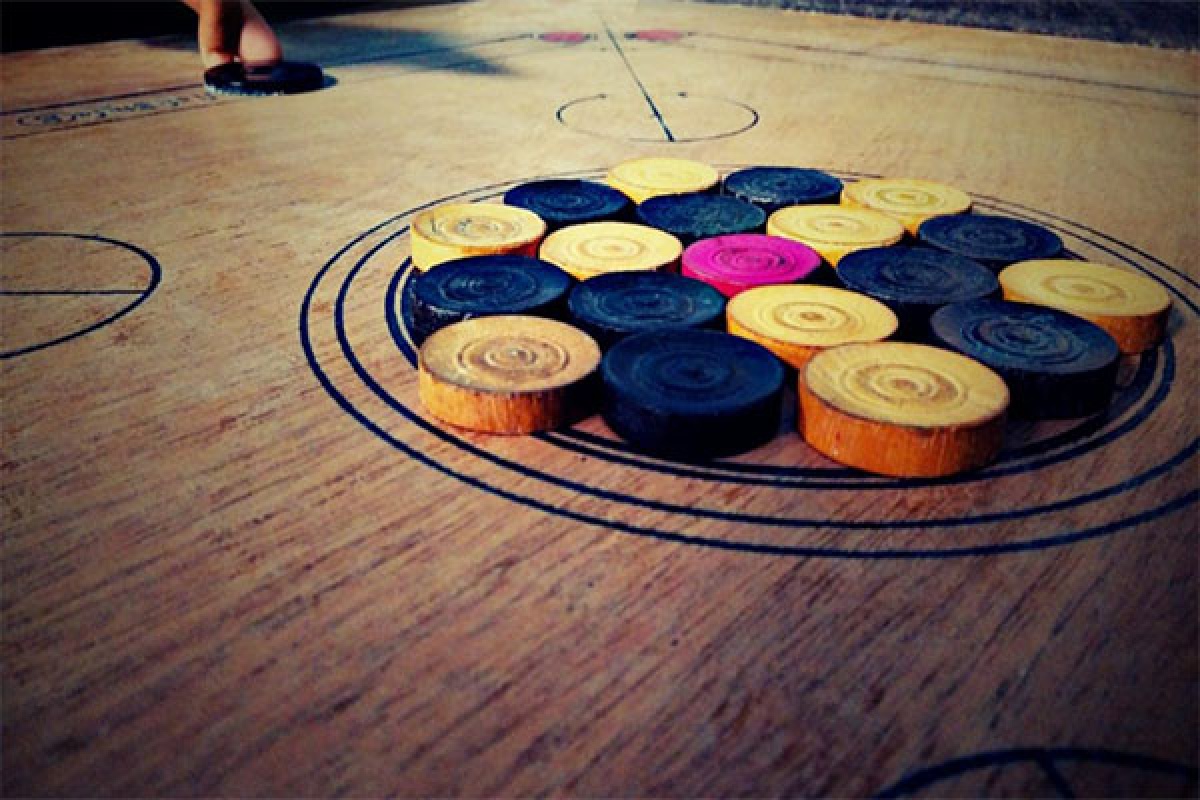
The Rules of Carrom or KaromCarrom or Karom is a game that has long been played in India and Southeast Asia, but the game has become increasingly popular in most parts of the world over the past century. There are a lot of differences in the carrom rules though there are an international regulatory body and several major national bodies, even these differences in the carrom rules depending on the situation. Masters Games build the following carrom rules on the UK Carrom Club rules(Carrom Rules), adapting them for simplicity whenever possible.EquipmentThe following dimensions vary greatly and are only presented as an example of a tournament board. Carrom Board is a flat, square, and smooth wooden board that can be 72 cm or 74 cm square and should be placed 60 to 70 cm above the ground(some of the carrom Rules). At each corner there is a circular hole that can be 51 mm in diameter and under each hole, there is a grid to catch billiard-like pieces. Two lines are drawn on the table along the diagonals. These are "fault lines". In the center, there are two concentric circles: the central circle is the size of one piece, and the main circle is about six times larger in diameter. Outside the circles and slightly inward on each side of the board, there are two straight lines parallel to the edge of the board. The distance between them should be approximately 3.8 cm and the long, thin space between them before the diagonal fault lines at each end ends with a red circle of 3.8 cm in diameter. This thin rectangle with circles at each end is called the "baseline", and the nearest baseline to a player in the area from which the player's striker should play.There are nine dark or black pieces and nine-light or white pieces plus a red piece called the "Queen". The smooth wood pieces are slightly smaller than the front piece, which is between 3.8 cm and 4.4 cm in diameter. People often have their own strikes which can also be bone or dentin and are usually somewhat heavier than the cut, although they may vary in weight from one-half to four times the weight of the piece. On some boards, potato starch, chalk powder, or other lubricant is used to make the pieces slide more easily over the surface of the plate; The most common lubricant is boric acid.PreparationTo decide who goes first, the player must hold a hidden piece with one hand. If the opponent correctly guesses which hand, the opponent chooses who goes first, otherwise, he chooses the player who hides the piece. The person who plays first aims to put the white pieces in a pocket.The game is played by two opponents seated opposite each other. To start, the queen is placed in the center of the board. Six pieces are placed directly around the queen in a circle, each touching the queen and her neighbors. The remaining twelve pieces are placed around the inner circle of six, with each outer piece touching the inner circle. Pieces must be switched in both circles. The two circles were oriented so that the queen, a white piece of the inner circle, and a white piece of the outer circle were in a straight line indicating the center of the side of the board where the player who would play first sits.ObjectivePlayers take turns playing. The turn consists of one or more hits. The player wins by putting all the pieces of the chosen color in their pockets first. However, no player can win until one player has "covered the Queen". To cover the queen, the player must place one of his pieces in his pocket right after the queen's pocket. If the queen is in her pockets but not covered, the queen is returned to the board. Both players usually try to cover the queen in addition to trying to win the game because the player who wins and covers the queen also gets extra points.StrikingFor each shot, the player must place the striker inside the baseline or in one of the two circles at each end of the baseline.The front inside the baseline should touch both the front line and the backline.An attacker cannot "cut the moon": must be placed partly inside the baseline and partly inside the circle.The player must hit the striker with his finger in order to cross the front end line; It is not allowed to do this horizontally or backward.The striker must not hit the piece on or behind the forward baseline until the attacker has crossed the forward baseline.When hitting, the player's hand or arm must not cross the diagonal lines of the bean at either end of the baseline.Basic rulesIn the first round, the player is allowed three attempts to "break", that is, disturb the central set of counters.It doesn't matter which piece the attacker hits first and it doesn't matter if the attacker doesn't hit any.If the attacker punches the queen and/or one or more pieces of his color, the player retrieves the attacking player and makes another hit.If the player does not pocket any piece or makes a mistake, the turn ends.Also Read: Pickleball RulesCovering the QueenA player can only put a pocket and cover the Queen if that player already has at least one piece of that player's color.If a player pockets the Queen before he is allowed to cover her, the role continues, but the Queen returns to the center at the end of the turn.If the player places the Queen and one of his private pieces in the same role, that is important and that player has covered the Queen. The said player must have already obtained at least 1 Piece to cover the Queen as usual.When a player places the Queen in the pockets but does not cover them, the opponent returns the Queen as close as possible to the central circle.Other RulesThe pieces that are returned to the center can be placed above the other pieces within the main circle.If the pieces stand on their edge or overlap with another piece, they are left as they are until they are moved again in the normal course of play.If the firing pin stops under another part, the firing pin should be removed with the least possible discomfort in the cover part.FoulsWhen a player commits a foul, the turn ends immediately and a penalty is imposed. The penalty is for the opponent to return a pocket piece to the board anywhere within the main circle. Any other pieces that must be returned to the board are also placed inside the main circle by the opponent. Naturally, pieces are placed to give the opponent an advantage.The error is recorded in the following situations:The striker is pocketed.Leave the racket or any other piece of the board.The player places the opponent's piece. If the queen is also hit by the pocket, the opponent returns her to the center with the penalty piece. Any other pieces that were placed in the pocket on the same hit remain in the pocket.The player places the opponent's last piece. Regardless of whether or not the Queen is covered, the opponent's piece is returned to the center in addition to the penalty piece.The player places the last piece before covering the queen. In this case, both the pocket piece and the penalty piece are returned to the center.The player breaks the carrom rules of hitting.The player touches any piece in play, except for the front.The first player to attack fails to break the meters with three attempts.Where a penalty is incurred but no pocketed pieces exist to return, the penalty is "owed" until a piece becomes available. If a penalty is owed, when a piece becomes available due to being pocketed, the piece is returned to the center by the opponent at the end of the turn. Should the opponent forget to do this before the start of the next turn, any owed penalties are lost.ScoringAt the end of the game, the winner scores 1 point for each opponent's piece remaining on the board. If the winner also installs the queen, an additional 5 points are scored. Thus the game's maximum score is 14 points.Usually, the match is played at 29 points and the match is played, if the winner's score reaches 24 points or more, 5 additional points are not added to cover the Queen.DoublesCarrom rules play four people at a rate of two. For the doubles game, the partners sit opposite each other and the turns continue in a clockwise direction. Other than that, the game is exactly the same as in the singles game. However, the game has a different character, because the pieces behind the baseline can be safely left for the partner to handle, unlike the singles game where the pieces located behind the baseline can only be. It moves by an opponent or bounces off the edges of the board.Also Read: TEQBALL: Teqball Rules | Teqball Challenges | Teqball players






